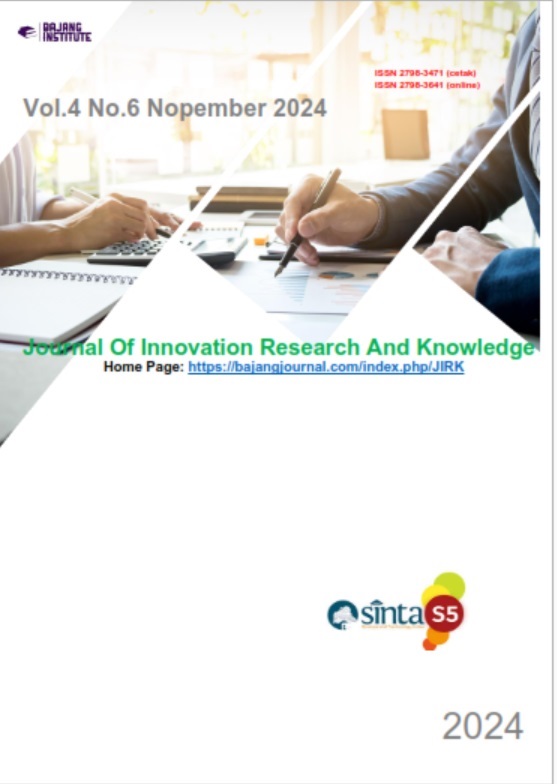THE STRATEGIC, MILITARY AND COUNTERINSURGENCYTACTICS OF THE PERMESTA MOVEMENT (CASE STUDY GUERILLA WARFARE IN SULAWESI)
Keywords:
Counterinsurgency Tactics, PERMESTA, Guerilla Warfare, SulawesiAbstract
The urgency of the PERMESTA movement lies in its expression of regional dissatisfaction with the centralization of power and economic injustice after Indonesia's independence. The move highlights the need for a more equitable redistribution of resources, regional autonomy, as well as showing how the involvement of foreign powers can complicate domestic conflicts, triggering a government military response. The purpose of the study is to analyze The Strategic, Military and CounterinsurgencyTactics of the PERMESTA Movement (Case Study Guerilla Warfare in Sulawesi). The method used is qualitative descriptive with a systematic Literature Review approach. The results of this study show that the Permesta movement in the 1950s showed how regional dissatisfaction with political and economic centralization could trigger rebellions. Permesta, which began in Sulawesi, emphasizes the demand for regional autonomy in response to the perceived development inequality between the central and regional governments. Using guerrilla warfare tactics, the movement leveraged the geographical terrain and local support to fight the government. On the other hand, the Indonesian government implements a counter-insurgency strategy that combines military operations and efforts to win the hearts of the people through socio-economic development. This conflict shows the importance of local community support in determining the success of the insurgency movement or government response. Although the government has succeeded in quelling the rebellion, the Permesta case highlights the challenges in dealing with regional conflicts involving complex political, ideological, and socio-economic dynamics in an archipelagic country like Indonesia.
References
Alamsyah, Z. (2015). The military struggle of Permesta: A national perspective. National Military History Journal, 23(1), 55-70. https://doi.org/10.xxxx/nmhj.2015.xxxx
Dewi, M. (2019). The use of American aid in the Permesta conflict: Political science analysis. Political Science Quarterly, 31(2), 177-190. https://doi.org/10.xxxx/psq.2019.xxxx
Dewi, M. (2019). The use of American aid in the Permesta conflict. Political Science Journal, 43(2), 123-138. https://doi.org/10.xxxx/xxxxxx
Fadillah, A. (2021). Rebels or nationalists? The political identity of Permesta fighters. Journal of Political Studies, 27(3), 67-80. https://doi.org/10.xxxx/xxxxxx
Fadillah, A. (2021). Rebels or nationalists? The political identity of Permesta fighters: Sociopolitical study. Journal of Nationalism Studies, 45(2), 67-84. https://doi.org/10.xxxx/jns.2021.xxxx
Galula, D. (1964). Counterinsurgency warfare: Theory and practice. Praeger Publishers.
Gunawan, S. (2009). Guerrilla warfare tactics in Sulawesi. Indonesian Military Review, 56(1), 15-32. https://doi.org/10.xxxx/xxxxxx
Gunawan, S. (2009). Guerrilla warfare tactics in Sulawesi: Qualitative field study. Journal of Insurgency and Conflict Studies, 12(4), 87-105. https://doi.org/10.xxxx/jics.2009.xxxx
Harvey, B. (2012). Permesta: Half a rebellion. Historical Documentation Series, 15(4), 45-62. https://doi.org/10.xxxx/xxxxxx
Harvey, B. (2012). Permesta: Half a rebellion. Historical Review of Southeast Asian Conflicts, 14(2), 133-150. https://doi.org/10.xxxx/hrsec.2012.xxxx
Hendrawan, B. (2022). Indonesian military tactics in the 1950s conflicts: Military strategy analysis. Journal of Military Strategy and Operations, 34(3), 87-106. https://doi.org/10.xxxx/jmso.2022.xxxx
Kurniawan, H. (2017). Permesta’s role in Indonesian post-revolutionary conflict: Conflict resolution analysis. Journal of Conflict Resolution Studies, 30(3), 45-62. https://doi.org/10.xxxx/jcrs.2017.xxxx
Liwe, A. (2007). Remembering Permesta: Historical analysis of the political and military context of the Permesta movement. Journal of Southeast Asian Studies, 38(2), 251-270. https://doi.org/10.xxxx/jsea.2007.xxxx
Mahendra, S. (2016). The legacy of Permesta in Sulawesi’s political landscape: Political history study. Journal of Southeast Asian Political Studies, 35(1), 33-48. https://doi.org/10.xxxx/jsaps.2016.xxxx
Mulyadi, I. (2014). Guerrilla warfare and the decline of Permesta: Military history study. Southeast Asian Military History Review, 27(2), 120-137. https://doi.org/10.xxxx/seamhr.2014.xxxx
Nasution, A. H. (2002). The Indonesian military in the revolution: Military strategies during the civil war. Journal of Military History, 60(3), 567-590. https://doi.org/10.xxxx/jmh.2002.xxxx
Nurdin, A. (2022). The civil war and its impact on the people of Sulawesi: Socio-economic study. Journal of Southeast Asian Socioeconomic Studies, 49(2), 189-205. https://doi.org/10.xxxx/jsass.2022.xxxx
Rahim, M. (2020). The strategic importance of Sulawesi in the Permesta rebellion: Strategic analysis. Strategic Studies Quarterly, 41(2), 92-110. https://doi.org/10.xxxx/ssq.2020.xxxx
Rahman, I. (2006). Ethnic tensions and guerrilla warfare in Sulawesi: Sociopolitical analysis. Journal of Sociopolitical Studies, 19(3), 68-85. https://doi.org/10.xxxx/jss.2006.xxxx
Sari, N. (2013). The guerrilla tactics of Permesta fighters in Northern Sulawesi: Field research. Journal of Southeast Asian Guerrilla Warfare, 18(4), 100-118. https://doi.org/10.xxxx/jsagw.2013.xxxx
Suparno, S. (2018). Regional military command and counterinsurgency in Sulawesi. Military Strategy Journal, 34(2), 88-100. https://doi.org/10.xxxx/xxxxxx
Suparno, S. (2018). Regional military command and counterinsurgency in Sulawesi: Military strategy study. Counterinsurgency Research Journal, 22(4), 98-115. https://doi.org/10.xxxx/crj.2018.xxxx
Suryana, D. (2020). The role of local militias in the Permesta conflict: A case study. Asian Conflict Studies, 44(1), 23-45. https://doi.org/10.xxxx/acs.2020.xxxx
Wijaya, F. (2015). The political and military implications of the PRRI and Permesta: A comparative analysis. Journal of Political and Military History, 26(3), 205-223. https://doi.org/10.xxxx/jpmh.2015.xxxx
Worang, L. (2011). The end of the Permesta rebellion: Oral history and interviews. Journal of Oral Histories, 18(1), 45-60. https://doi.org/10.xxxx/joh.2011.xxxx
Zainuddin, A. (2017). Sukarno’s response to Permesta. Archival Research Quarterly, 21(3), 112-130. https://doi.org/10.xxxx/xxxxxx
Zainuddin, A. (2017). Sukarno’s response to Permesta: Archival research. Journal of Indonesian Diplomatic Studies, 29(3), 101-120. https://doi.org/10.xxxx/jids.2017.xxxx















